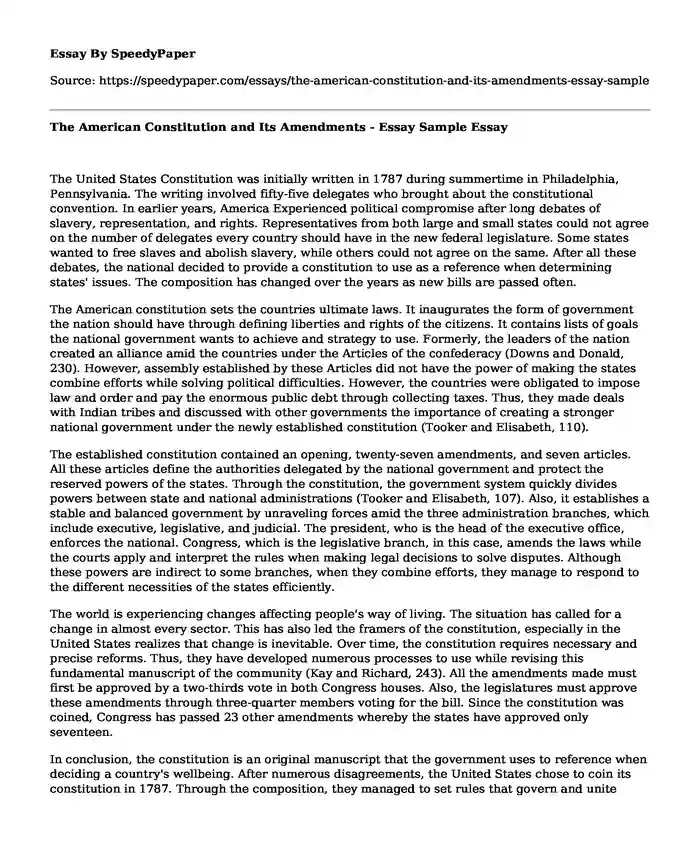
| Type of paper: | Essay |
| Categories: | Constitution |
| Pages: | 3 |
| Wordcount: | 624 words |
The United States Constitution was initially written in 1787 during summertime in Philadelphia, Pennsylvania. The writing involved fifty-five delegates who brought about the constitutional convention. In earlier years, America Experienced political compromise after long debates of slavery, representation, and rights. Representatives from both large and small states could not agree on the number of delegates every country should have in the new federal legislature. Some states wanted to free slaves and abolish slavery, while others could not agree on the same. After all these debates, the national decided to provide a constitution to use as a reference when determining states' issues. The composition has changed over the years as new bills are passed often.
The American constitution sets the countries ultimate laws. It inaugurates the form of government the nation should have through defining liberties and rights of the citizens. It contains lists of goals the national government wants to achieve and strategy to use. Formerly, the leaders of the nation created an alliance amid the countries under the Articles of the confederacy (Downs and Donald, 230). However, assembly established by these Articles did not have the power of making the states combine efforts while solving political difficulties. However, the countries were obligated to impose law and order and pay the enormous public debt through collecting taxes. Thus, they made deals with Indian tribes and discussed with other governments the importance of creating a stronger national government under the newly established constitution (Tooker and Elisabeth, 110).
The established constitution contained an opening, twenty-seven amendments, and seven articles. All these articles define the authorities delegated by the national government and protect the reserved powers of the states. Through the constitution, the government system quickly divides powers between state and national administrations (Tooker and Elisabeth, 107). Also, it establishes a stable and balanced government by unraveling forces amid the three administration branches, which include executive, legislative, and judicial. The president, who is the head of the executive office, enforces the national. Congress, which is the legislative branch, in this case, amends the laws while the courts apply and interpret the rules when making legal decisions to solve disputes. Although these powers are indirect to some branches, when they combine efforts, they manage to respond to the different necessities of the states efficiently.
The world is experiencing changes affecting people's way of living. The situation has called for a change in almost every sector. This has also led the framers of the constitution, especially in the United States realizes that change is inevitable. Over time, the constitution requires necessary and precise reforms. Thus, they have developed numerous processes to use while revising this fundamental manuscript of the community (Kay and Richard, 243). All the amendments made must first be approved by a two-thirds vote in both Congress houses. Also, the legislatures must approve these amendments through three-quarter members voting for the bill. Since the constitution was coined, Congress has passed 23 other amendments whereby the states have approved only seventeen.
In conclusion, the constitution is an original manuscript that the government uses to reference when deciding a country's wellbeing. After numerous disagreements, the United States chose to coin its constitution in 1787. Through the composition, they managed to set rules that govern and unite them, work towards the same goals. Over the decades, Congress has managed to amend other laws due to the current evolution of things. However, the states have rejected some of these laws, a sign that it is difficult to change a constitution
Works cited
Downs, Donald Alexander. "First Amendment Blues." Persuasions and Prejudices. Routledge, 2017. 225-234.
Kay, Richard S. "Formal and Informal Amendment of the United States Constitution." The American Journal of Comparative Law 66.suppl_1 (2018): 243-268.
Tooker, Elisabeth. "The United States Constitution and the Iroquois League." The Invented Indian. Routledge, 2017. 107-128.
Cite this page
The American Constitution and Its Amendments - Essay Sample. (2023, Mar 30). Retrieved from https://speedypaper.net/essays/the-american-constitution-and-its-amendments-essay-sample
Request Removal
If you are the original author of this essay and no longer wish to have it published on the SpeedyPaper website, please click below to request its removal:
- Free Essay: Different Standards and Expectations from Sons and Daughters
- Why Should We Go to College, Essay Example at No Charge
- Free Essay: Progressive Emergent Curriculum Proposal. NAEYC Standard.
- Paper Example on Preparing Couples for Marriage
- Essay Sample on Corporate Governance in Sports Direct
- Essay Sample on Short-Term Investment Returns: Money Market Instruments
- Paper Example: The Perfect Poem
Popular categories




